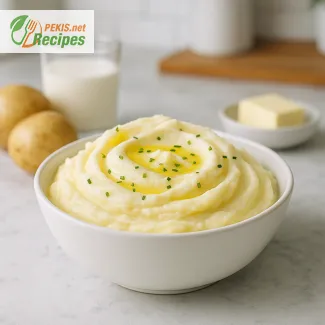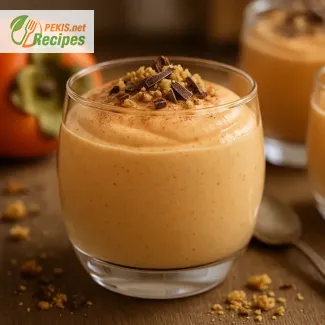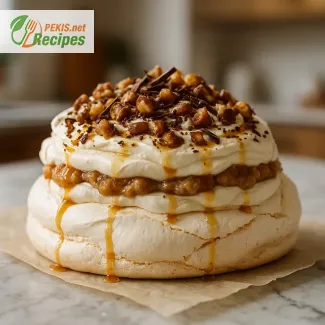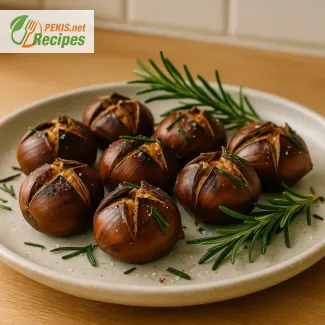A bowl of beet and horseradish soup brings a deep, velvety sweetness from slow-cooked beets and a bright, warming kick of freshly grated horseradish. Its vibrant colour and creamy texture feel both rustic and elegant, echoing old Central European winter traditions while delivering a rich, comforting spoonful with every bite.
Sometimes the smallest tweak transforms a simple soup into something unforgettable—fresh horseradish added at the very end keeps its clean heat bright and alive, lifting the natural sweetness of slow-cooked beets. Drawing on years of refining winter recipes and balancing earthy flavours with lively acidity, this bowl becomes both comforting and energising.
PEKIS – professional chef and recipe developer with over 25 years of experience in cooking and baking, specialised in European and international cuisine.
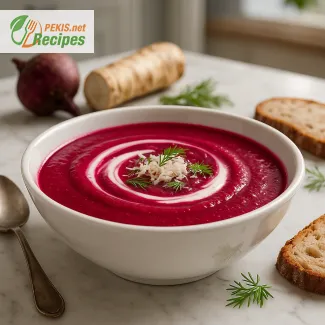
Velvety Beet and Horseradish Soup to Warm Cold Evenings
A vibrant deep-pink bowl with gentle heat, earthy sweetness and creamy comfort
The first spoonful of beet and horseradish soup hits with a soft, silky texture, then comes the layered flavor: earthy sweetness from roasted beets, a gentle fiery tingle from fresh horseradish and a cool, creamy swirl of dairy that softens everything into a smooth, comforting finish. Steam rises in delicate pink clouds, the colour glowing against the bowl, and suddenly a grey winter evening feels a little brighter, a little more luxurious, and a lot more inviting.
Behind that striking colour is a smart combination of simple ingredients. Slowly cooked or roasted red beets bring depth, body and natural sweetness, while freshly grated horseradish adds a clean, sinus-clearing warmth that wakes up the palate without overpowering it. A good vegetable or light meat stock gives structure, a splash of vinegar or lemon juice sharpens the edges, and a spoonful of sour cream, crème fraîche or Greek yogurt lends the soup its velvety mouthfeel. Finished with toasted seeds, fresh herbs or crunchy croutons, this bowl feels both rustic and refined at the same time.
What makes beet and horseradish soup so special
This kind of beet soup leans into contrast: sweet vs. sharp, creamy vs. spicy, rustic vs. elegant. It works beautifully as a starter for a winter feast, but is substantial enough to serve as a light main course with a thick slice of crusty bread or a piece of toasted sourdough. Because the base is mostly vegetables, it feels nourishing and light, yet the texture is rich enough to satisfy on cold days when only a hot, colourful bowl will do.
- The colour is naturally intense and impressive, perfect for festive tables.
- The heat from horseradish feels cleaner and brighter than chili, ideal for guests who prefer aromatic warmth over burning spice.
- The texture can be adjusted from rustic and chunky to perfectly smooth, depending on how thoroughly it is blended.
- The flavour profile pairs well with many winter dishes, from roasted meats to potato gratins and hearty breads.
A short look at the roots of beet and horseradish soup
Versions of beet soup are deeply rooted in Central and Eastern Europe, where beets have long been a staple winter vegetable. Think of iconic dishes like borscht, often served with a dollop of sour cream. Horseradish has its own strong tradition, especially around festive occasions, frequently served grated alongside smoked meats, sausages and cured fish. Bringing beets and horseradish together in one smooth soup feels like a natural evolution of these traditions: the beet offers colour and sweetness, the horseradish brings the familiar festive heat, and dairy ties the two into a single, comforting bowl.
In winter menus, it is easy to build an entire course sequence around these flavours. A bright soup like this works beautifully before a main dish and after a light dessert such as fruit-based puddings or creamy berry dishes. For example, you can serve the soup before a classic German-style berry dessert such as Traditional Red Berry Grütze – A Classic Northern German Dessert Delight to keep the menu colourful yet balanced.
Key ingredients and how they shape the flavor
Each component influences the personality of this beet and horseradish soup:
- Beets – Provide natural sweetness, colour and body. Roasting brings out caramelised notes, boiling keeps the flavour cleaner and earthier.
- Horseradish – Adds a sharp, nasal heat that cuts through the sweetness. Freshly grated root is more vibrant than prepared cream, so the amount can be tailored to personal preference.
- Onions, leeks or shallots – Build a gentle savoury base and help round out the earthy notes.
- Garlic – Used sparingly, it gives quiet depth without pushing the soup into strongly garlicky territory.
- Stock or broth – A light vegetable or chicken stock keeps the colour clear and the taste balanced.
- Acidic component – A small amount of apple cider vinegar, red wine vinegar or lemon juice brightens flavours and prevents the soup from tasting flat.
- Dairy – Sour cream, yogurt or crème fraîche create a creamy, velvety texture and temper the horseradish heat.
- Toppings – Fresh dill, chives, parsley, toasted pumpkin or sunflower seeds, crispy bacon or croutons provide contrast in texture and flavour.
Choosing the right beets and horseradish
For the best result, it pays to choose the freshest beets and firm, heavy horseradish roots you can find. Smaller beets tend to be sweeter and more tender, with a finer texture once blended. Horseradish should smell pungent and bright; if it is dull or fibrous, the flavour may be muddy rather than clean and sharp. When the base is this simple, ingredient quality shows in every spoonful.
Serving ideas and seasonal pairings
This soup can be styled in many ways, depending on the occasion:
- Ladle into small cups or shot glasses for an elegant amuse-bouche.
- Serve in deep bowls with a generous swirl of cream and a handful of crunchy toppings for a satisfying lunch.
- Pair with dark rye bread, seed-studded loaves or garlic croutons for extra texture.
- Add a topping of flaked smoked fish, roasted chickpeas or shredded roast chicken when a more filling main course is needed.
On festive winter tables, it pairs beautifully with roast poultry, game or pork, and also with richer desserts that echo the season. If a creamy, show-stopping dessert is on the menu, consider something like Roasted Chestnut and Vanilla Cream Pavlova – Elegant Winter Dessert to continue the cosy winter theme.
Storage and make-ahead tips for busy days
Beet and horseradish soup fits naturally into meal prep routines:
- The base soup without dairy can usually be kept in the fridge for a couple of days in a sealed container.
- Dairy and extra horseradish can be stirred in just before reheating to keep the flavour bright and the texture smooth.
- The soup often tastes even better the next day, after the flavours have had time to meld.
- Portions can be frozen without the final cream swirl; fresh cream or yogurt can be added after reheating for best texture.
Why you’ll love this beet and horseradish soup
- Striking colour that makes the table look festive with almost no effort.
- Balanced flavour where sweetness, acidity and heat work together instead of competing.
- Flexible texture you can keep rustic or blend until completely smooth.
- Simple ingredients that are easy to find and budget-friendly.
- Perfect winter comfort that still feels light and vegetable-forward.
- Versatile serving options, from elegant starter to full meal with hearty bread.
Creative variations to try
Once the basic beet and horseradish soup is mastered, it is easy to tailor it to taste, season or occasion:
- Add roasted carrots or parsnips for extra sweetness and a slightly different shade of pink.
- Swap part of the stock for a small splash of dry white wine and cook off the alcohol for added complexity.
- Stir in a spoonful of creamy goat cheese or feta at the end for tangy richness.
- Finish with orange or lemon zest for a delicate citrus aroma.
- Use plant-based cream or coconut milk to create a dairy-free version while keeping the soup silky.
- Top with microgreens, finely sliced raw beet ribbons or pickled onions for added acidity and crunch.
With these tweaks, the same core idea can appear on the table in many forms throughout the season, always familiar but never repetitive.
- Wash the beets thoroughly, peel them and cut into small cubes for even cooking.
- Finely chop the onion, carrot and garlic. Grate the fresh horseradish and set aside.
- Melt the butter in a large pot over medium heat. Add onion, carrot and garlic. Cook for 5–6 minutes until soft and fragrant.
- Add the cubed beets and stir well to coat with the aromatics.
- Pour in the vegetable stock and bring to a boil. Reduce heat, cover and simmer for 35–40 minutes until the beets are completely tender.
- Add lemon juice, salt, pepper and half of the grated horseradish. Stir and simmer for 2 more minutes.
- Use an immersion blender to blend the soup until smooth and velvety.
- Taste and adjust seasoning. Add more horseradish if you prefer a stronger heat.
- Serve hot with a swirl of sour cream and garnish with fresh dill.
FAQ questionCan beet and horseradish soup be made ahead without losing flavor?
Yes, this soup actually improves in flavor when made ahead, as the beets, stock and horseradish have time to meld. The key is to cook and blend the soup base without dairy, cool it completely and store it in an airtight container in the fridge for up to 2–3 days. Add sour cream or yogurt only when reheating and serving, so the texture stays silky and smooth and the horseradish heat remains bright rather than fading or turning dull.
FAQ questionHow much horseradish should be used so the soup is spicy but not overpowering?
Horseradish is powerful, so it is better to build the heat gradually. For a balanced bowl, start with a small amount mixed into the pot (for example ½–1 tbsp per 4 servings) and let it simmer briefly. Then, right before serving, stir in a little extra freshly grated horseradish to taste or offer more at the table. This two-step approach keeps the flavour layered and aromatic, with a clean nasal warmth instead of a harsh burn.
FAQ questionWhat is the best way to get a velvety texture in beet and horseradish soup?
To achieve a truly velvety texture, make sure the beets are fully tender before blending; they should pierce easily with a knife. Use an immersion blender directly in the pot and blend longer than expected, scraping the bottom and sides so no chunks remain. If an ultra-smooth finish is desired, pass the soup through a fine mesh sieve. Adding a moderate amount of cream, sour cream or thick yogurt at the end helps create a creamy, luxurious mouthfeel without making the soup heavy.
FAQ questionCan this soup be made lighter or fully plant-based?
Absolutely. The base of the soup is naturally vegetable-focused, so it converts well to a lighter or vegan version. Use vegetable stock, skip butter in favour of olive oil or another neutral oil, and replace sour cream with plant-based cream or unsweetened plant yogurt. The result is still creamy and satisfying, with the beets providing body and sweetness, while the horseradish keeps the flavour bright and exciting without relying on dairy.
FAQ questionWhat should be served with beet and horseradish soup to make a full meal?
This soup pairs beautifully with crusty bread, seeded rolls or dark rye, which balance the earthy sweetness and give the meal more substance. For extra protein, add a topping of roasted chickpeas, shredded roast chicken, smoked fish flakes or toasted pumpkin seeds. A simple green salad with a sharp vinaigrette works well on the side, cutting through the soup’s richness and highlighting its sweet–sharp contrast.
FAQ questionWhy does beet and horseradish soup work so well in winter menus?
The combination of deep, earthy beets and warming horseradish is naturally suited to cold weather. The soup is colourful and comforting, yet not too heavy, so it can be served before a main dish without overwhelming the palate. Its vibrant pink-red colour brings visual warmth to the table, while the gentle heat from horseradish gives the same cosy feeling as other spicy dishes but in a cleaner, more aromatic way. This makes it an ideal starter or light main course for winter gatherings and festive menus.
A warm bowl of beet and horseradish soup brings together colour, comfort and a depth of flavour that feels perfectly aligned with cold-season cooking. The balance of earthy sweetness, clean heat and creamy richness creates a sensory experience that stands out both on the table and in memory.
The combination of slowly cooked beets and freshly grated horseradish offers a unique contrast: silky texture paired with a bright, aromatic kick. It’s the kind of dish that feels nourishing yet elegant, making it ideal for weeknight meals as well as festive winter gatherings.
Because the base relies on simple, accessible ingredients, the soup adapts beautifully to different preferences. Adjusting the amount of horseradish, choosing your style of creaminess and adding layered toppings allow the bowl to feel personalized and expressive without complicating the process.
Small details—like adding a splash of acidity, blending until velvety or finishing with herbs—help the flavours open up fully. With minimal effort, the result becomes a dish that feels both deeply comforting and visually striking, perfect for slow evenings or shared winter tables.
Allergens present in the recipe:
- Dairy: Sour cream contains milk proteins
- No gluten: Naturally gluten-free
How to remove allergens and gluten:
- Replace sour cream with plant-based cream to make the recipe dairy-free
- Ensure the vegetable stock is certified gluten-free
- Vitamin C (mg): 11 – contributes to immune support
- Iron (mg): 1.2 – essential for oxygen transport
- Potassium (mg): 360 – supports healthy muscle and nerve function
- Folate (mcg): 95 – important for cell regeneration
- Magnesium (mg): 28 – supports energy production
- Betalains (mg): 25 – known for anti-inflammatory effects
- Vitamin A (mcg): 42 – supports vision and skin health
- Polyphenols (mg): 40 – contribute to cellular protection against oxidative stress

